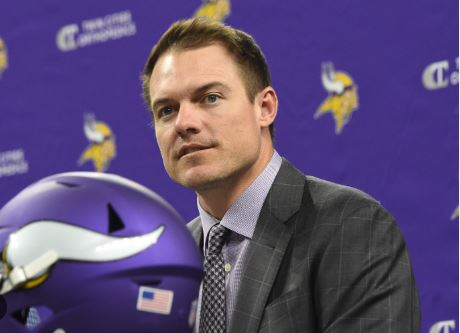
How Much Will Justin Jefferson Need to Be Signed Again by the Vikings?
Since the major NFL media has decided that Justin Jefferson’s decision to skip the Minnesota Vikings’ voluntary organized practice is news, I suppose it’s time to talk about his contract situation once more.
Vikings supporters have gone through this drill what seems like a thousand times by now. We endured the same rumors during the previous offseason, and no deal was reached. There was a lot of discussion about Kirk Cousins’ impending free agency and the possibility that Jefferson wouldn’t want to play with a different quarterback. Sadly, until Jefferson signs a contract extension with Minnesota and puts pen to paper, this cycle will continue.
Regarding Minnesota’s ability to re-sign Jefferson, I have no concerns. The team intends to extend Kwesi Adofo-Mensah, the general manager has stated on multiple occasions. He obviously isn’t able to speak with absolutes. He has, nevertheless, shown all of his strength without fully committing to something that hasn’t occurred yet.
Sadly, Jefferson’s only real choice if the Vikings want to keep him is to threaten to sit him out. The projected 2025 WR franchise tag is $24.8 million; if Jefferson is tagged twice, he will receive $29.7 million in 2026. For the NFL’s top receiver, that’s a steal. In 2027, Minnesota may even offer him a third tag for $42.8 million. A.J. Brown signed a three-year, $96 million extension with the Philadelphia Eagles this offseason; that contract would increase by a small amount if those three years were averaged out to be about $32.5 million per season.
The Vikings shouldn’t be concerned about losing Jefferson to free agency because of the franchise tag option. The best outcome, though, would be a long-term extension that would satisfy Jefferson and enable the team to make clear financial plans for the future. What sort of agreement then completes this move?

To help Jefferson know what to expect, let’s look at four contracts.
THE MOST EXPENDABLE WRS
It makes sense, of course, to contrast Jefferson with the highest-paid players in the same position. Amon-Ra St. Brown and A.J. Brown recently signed contracts with the top two. The three players—Brown in 2019; Jefferson in 2020; and St. Brown in 2021—were selected in consecutive drafts.
Given his age and contract status, St. Brown is a more accurate comparison. Brown is roughly two years older than Jefferson (25 in June) and St. Brown (25 in October), who both turn 27 in June. While Brown signed his first extension in 2022 and then another this offseason, St. Brown also signed his four-year, $120 million extension following his rookie contract.
Here is Over the Cap’s version of St. Brown’s contract:
First thing to note is that St. Brown’s salary guarantee only extends until 2025. His salary has rolling guarantees that ensure he will receive his entire 2026 salary in 2025 and $7.4 million of his 2027 salary in 2026. The stated figures—$77 million guaranteed over four years and $120 million overall—appear excellent. Nevertheless, by cutting him after the 2026 campaign, the Detroit Lions will be able to save money.
Brown has an even more convoluted contract. Below is an explanation of his contract following his extension:
Brown was bound until 2026 by his previous contract, which he signed. Consequently, even though he is now the “highest paid receiver,” he won’t begin to receive that money until 2027, when the cap is expected to increase by 23% to $314 million from its current level. Translating that into the current cap environment, the annual cost comes to $26 million.
It would be $26.5 million as opposed to the anticipated cap in 2025, the first year of a new Jefferson deal. Furthermore, of the $92 million, only $16 million is guaranteed. However, Brown’s main advantage from this new agreement is that it guarantees the balance of his 2022 contract. Thus, through 2026, every dollar is essentially guaranteed. The Eagles would find it challenging to move on early given the terms of the contract given how much money they’re investing in the future.
THE MOST EXPENDABLE NON-QB
But Jefferson’s goal goes beyond simply being the highest paid wide receiver. Being the highest paid non-QB is his goal. Nick Bosa currently holds that title, as evidenced by his five-year, $170 extension in 2023, which is a substantial amount more than any other non-QB contract.
This is an overview of his agreement:
Bosa’s contract and Amon-Ra St. Brown’s differed significantly, aside from the annual salary. The full guarantee for the third year of St. Brown’s contract, 2026, won’t be available until 2025. On April 1, 2024, Bosa’s rolling guarantee became fully guaranteed. In the meantime, $20 million of his third year’s salary, or 2025, was fully guaranteed at signing. The remaining $10.5 million was guaranteed for injury. Bosa’s salary for 2026 is also fully guaranteed in 2025, but St. Brown’s salary guarantee won’t kick in until his fourth year.
Considering that 2023 was Bosa’s fifth-year option and St. Brown was in the fourth year of a rookie contract selected in the fourth round, it’s also noteworthy that Bosa had a higher starting point. Considering those two things, Jefferson’s contract will probably match or even exceed Bosa’s, not just St. Brown and Brown’s.
A QB DEAL RECENTLY
QBs operate in a different class from the rest of the league because of the importance of the position. It would be absurd to compare Jefferson to any QB in terms of money. However, I think Jared Goff’s new contract is interesting from a structural standpoint. Even though Goff isn’t among the best quarterbacks, he still benefits greatly from his structure, as shown below:
Like Bosa, Goff’s third-year salary is largely guaranteed, with a rolling guarantee that becomes fully guaranteed the season prior. Furthermore, $18 million of Goff’s 2027 salary is guaranteed in 2026. The first exit is after 2026, and with a dead cap of nearly $50 million once the $18 million becomes guaranteed, it would come with a heavy price.
If a starting quarterback who is not exceptional can have such a structure, Jefferson’s team will probably push for something similar.
EXPECTING JEFFERSON’S AGREEMENT
We can extract details from the aforementioned contracts in order to project Jefferson’s deal. Given his standing as a player, it makes sense that Jefferson would surpass Bosa in terms of average annually. But how much is that? Should Jefferson’s new contract take into consideration the salary cap increase from 2023 to 2024 when comparing it to Bosa?
You might think so if you accept the other two WR contracts at face value. Josh Allen and Brian Burns, the two top edge rushers signed this offseason, were greatly outperformed by St. Brown and Brown. However, Burns and Allen signed their contracts as franchise-tagged pending free agents, so there is no early-season discount for a cheap year. As I indicated earlier, Brown’s deal is essentially worth $26 million in 2024 currency. If you look at St. Brown’s entire contract, he will be paid $24.7 million annually for the following five years. Both of those are less than the approximately $28 million that Burns and Allen received. These four players all occupy the same space because they are all superior at what they do. They are not as good as the recurring OPOY and DPOY favorites, Jefferson and Bosa, though.
It appears that the league still prefers edge rushers to wide receivers because the four players listed above are in a comparable class. As a result, I anticipate Jefferson to defeat Bosa; however, I do not anticipate him surpassing him by the 13.6% increase in the NFL salary cap from 2023 to 2024. There was a 7.7% discrepancy between the best edge rushers and the Brown deal’s effective value. With Nick Bosa’s contract, you can take that difference and adjust for inflation to get approximately $35.87 million annually. We can use that as our basis for his contract, rounding up to $36 million.
We must now consider contract length. Although Bosa’s contract was only for five years, it wasn’t as long as either of the wide receivers’ contracts. Amari Cooper and Davante Adams are the only two of the eighteen receivers who earn more than $20 million annually who are on five-year contracts. All other players, such as D.K. Metcalf, Calvin Ridley, Tyreek Hill, and Cooper Kupp, have contracts that last three or four years. Though Jefferson will likely ask for a shorter contract so he can cash in again as contracts continue to rise, the Vikings will almost certainly want to sign him for as long as possible. I’ll therefore estimate it to be a four-year agreement.
Structure is the next thing to think about. We should trust Bosa and Goff’s contract over Brown and St. Brown in this instance. Being a superstar and past OPOY puts Jefferson in a unique position where he can demand a deal that includes strong guarantees into the fourth year and a functionally guaranteed third year.
Therefore, the Vikings are considering offering Jefferson an extension worth $144 million for four years. The Vikings would pay him $163.7 million over five years, or slightly less than $32.75 million per season, if his 2024 salary is factored in. As per the structure, I will provide rolling guarantees for the remaining salary and the entire fourth-year salary, but I will fully guarantee the first two years of the deal and a portion of the third year, similar to Goff and Bosa. The fifth and final year will then be uncertain as a result.
It is now necessary to ascertain the signing bonus. Assume the Vikings wish to pay Jefferson $55.473 million, which is his salary for 2024 plus one year of the new salary as a signing bonus. The minimum salary required to be paid to a player is the league minimum, which for Jefferson is $1.125 million in 2025 and $1.17 million in 2026. We’ll round up to $53 million if you take that out and add the $500,000 in annual roster bonuses per game. That comes out to $52.9 million.
Option bonuses are the last detail. These work similarly to signing bonuses for cap purposes, but they are fixed for the year you place them. Contracts with Bosa, Brown, and St. Brown contain them. In the second year of the agreement, I chose to give Jefferson a $16 million option bonus, and in the third year, I chose to give Bosa a $30 million option bonus (along with a minimum salary). You could just think of these as salary additions as they aren’t really necessary. The last two years’ salaries are then all that remains to project; I put them, rather arbitrary, at $26.2 million in Year 4 and $34 million in Year 5.
Reports would indicate that this contract is a four-year, $144 million extension with a massive $109 million guaranteed; however, only $87.5 million is fully guaranteed, falling just short of Bosa’s agreement. The contract would appear as follows on an OTC page:
WAITING—DID THE VIKINGS HURT THEMSELVES?
People love to make headlines about Jefferson’s rising price over time, especially Mike Florio of PFT. But in June of last year, I estimated Jefferson’s annual cost to be $35 million. Waiting is hardly a significant increase or mistake on the part of the Vikings, even though I added $1 million to that estimate.
It should be the goal of Jefferson’s agency to drive the market as high as possible for him. Considering that the parties were reportedly in close contact prior to the 2023 season, that is probably the reason the deal hasn’t been finalized yet. It is likely that Jefferson’s representation is requesting deeper rolling guarantees than what I have proposed above as well as more upfront guarantees rather than rolling ones. Nevertheless, it will most likely eventually align with the agreements made by Bosa and Goff.
Leave a Reply